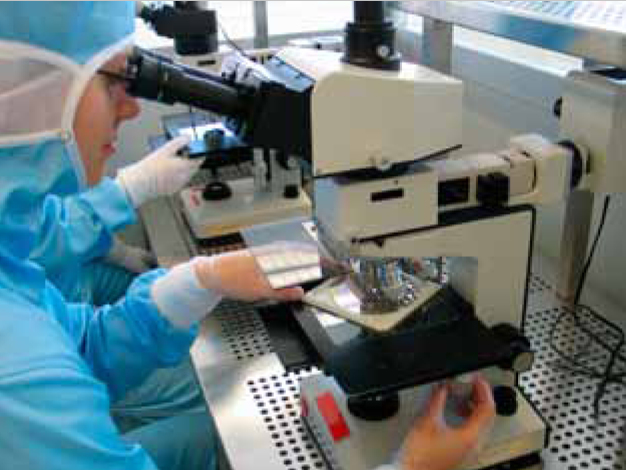- Furnishing & equipment
The devil is in the details!
Humidity measurement in cleanrooms
Thoughts on selecting and using appropriate humidity measurement equipment for cleanrooms.
Every cleanroom has specifications for environmental control that define upper and lower limits for temperature and relative humidity (RH). Creating and maintaining these conditions in the cleanroom is no small feat, and this must be achieved while also controlling pressure, flow, and contamination.
Devices used for measuring RH (variously referred to as sensors, transmitters, or instruments) play a small role in the overall picture, but problems with these devices can cause significant headaches for cleanroom operators. What follows are some observations that may be relevant to anyone in the cleanroom community who has struggled with humidity issues.
Identify the correct installation location
Relative humidity is a temperature dependent parameter. This has implications for the placement and installation details of RH instruments. For example, if an instrument with a 200 mm stainless steel probe is installed with only 50 mm of the probe in the process air, the other 150 mm of the probe may serve as a heat sink or source, depending on the environment surrounding it.
Even in carefully executed probe designs this can change the temperature of the actual humidity sensing element and introduce an RH measurement error that will vary with the difference between the process air temperature and the environment surrounding the exposed portion of the probe. Does this sound implausible? It is easily measured in a laboratory environment.
Local heating can also cause problems for wall mounted RH instruments, so care must be taken to locate the devices away from any equipment or apparatus that generates heat. Good airflow in the cleanroom usually minimizes convective heat problems, but warm or hot equipment will radiate heat, creating the possibility of a temperature discrepancy and corresponding measurement error. Also, when specifying RH instruments for wall installations, consider that any loop powered device with a 4 – 20 ma output will necessarily dissipate some power as heat.
Incredibly, some wall mounted RH devices housed in attractive enclosures self-heat by several degrees, causing significant measurement error. Avoid this possibility altogether by specifying RH devices with short probes that isolate the humidity sensing element from the electronics of the instrument. Does this sound implausible? Again, this is easily measured in a laboratory environment.
While we’re thinking about installation locations, let’s return to duct sensors for a moment and the subject of humidification and de-humidification. Humidity sensors should never get wet. They should be located far enough downstream from cooling coils so that they are unlikely to be impacted by any entrained water droplets. The same is true for steam injection or ultrasonic humidification elements.
In practice, many RH probes are equipped with filters that eliminate catastrophic errors by protecting the sensing element from water. However, water can accumulate on or in the filter material, creating a microclimate around the sensor that results in measurement error. Does this sound implausible? This too is easily measured in a laboratory environment.
In all of the scenarios described above, measurement errors are induced by subtle factors that may come and go, change over time, or occur only seasonally. These situations are among the most difficult to troubleshoot. If the errors are big enough to create out of specification conditions, they will trigger service calls, calibration requests, and equipment replacement, so these errors are also expensive. It is best to prevent these problems in the design and specification processes.
Pay attention to long term stability
Now we are ready to prevent problems, so we will move out of the cleanroom and upstream to the instrument specification process. This is a good time to think about the accuracy specifications of the various instruments available for purchase. Instrument prices vary with accuracy, and accuracy appears to be an important characteristic of an RH instrument.
Should accuracy specifications be decisive when specifying an RH instrument? Not necessarily. Instrument makers focus on these numbers and sometimes make performance claims that can be misleading. This is technically allowable because “accuracy” is a qualitative term in measurement science. A true understanding of instrument performance requires some knowledge of measurement science and the concept of measurement uncertainty. These subjects can be explored on the web (National Conference of Standards Laboratories, www.ncsli.org), but we digress, because there is a peformance factor that is far more important that accuracy.
Long term stability is easily the most important performance characteristic of an RH instrument. This is the ability of the instrument to make “accurate” measurements consistently over a long period of time. Reputable firms will run long term tests to characterize their own devices. Look at the results of these tests to understand baseline performance, but be aware that performance in your cleanroom may be different. The most significant threat to the long term stability of an RH instrument in a cleanroom is the presence of vapors from chemicals used in cleanroom processes. Some RH devices are equipped with features to minimize the effect of chemicals. Ask the instrument makers about these features if this issue is a concern in your facility.
Many humidity measurement problems in a cleanroom can be anticipated and prevented with some thoughtful planning. Care should be taken throughout the entire RH instrument specification and installation processes. When in doubt, contact your instrument maker and seek experienced guidance.
Jim Tennermann / Regional Market Manager / Vaisala / Boston, MA, USA
picture: Careful placement of humidity sensors results in accurate measurements and reliable long-term performance.
![]()
Vaisala GmbH
Rheinwerkallee 2
53227 Bonn
Germany
Phone: +49 228 249710
Fax: +49 228 2497111
email: vertrieb@vaisala.com
Internet: http://www.vaisala.de









